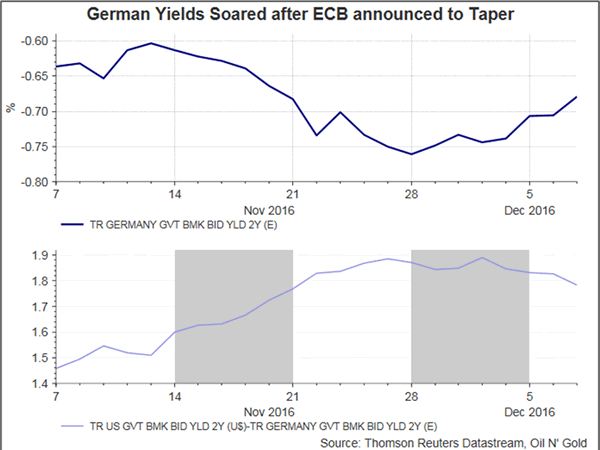ECB surprised the market by announcing tapering plan for its bond purchases program. The Governing Council decided to extend the program until December 2017. However, the pace would slow down to 60B euro per month from April 2017, compared with the current 80B euro. The market generally anticipated ECB to extend the program for 6 months without changing the pace of purchases. The market was disappointed. German yields spiked to a one-year high. The single currency soared to a one-month high of 1.0872 immediately after the announcement. However, gains were erased with EURUSD dropping more than -1%, as ECB left the door open to extend QE further beyond December 2017 and/or pick up the pace of bond buying again if the economic conditions deteriorate. Despite disappointing in first sight, the ECB has indeed delivered more than the market had anticipated: 9 months*60B euro = 540B euro vs consensus of 6 months*80B euro = 480b euro. Has the ECB has again disappointed the market by doing more?

At the press conference, President Mario Draghi indicated that the "calibrations" announced reflect the "moderate but firming recovery of the euro area economy" and the "subdued underlying inflationary pressures". He added that the members still expect the region’s economy to recover at a "moderate but firming" pace with the risks to growth are skewed to the downside. In answering a question regarding the advantage of extending QE for 9 months at 60B euro per month, over an extension for 6 months a 80B euro per month. Draghi noted that ECB wants to ensure a sustained pressure on market prices, without distorting them of course. He affirmed that the reduction in size does not mean tapering. There were also some changes in the parameters of the QE with the ECB now allowed to buy government bonds which are yielding less than its deposit rate of -0.4%. Moreover, there are some changes to its securities lending program with cash now accepted as collateral.

The Governing Council also released its latest staff economic projections. GDP is now expected to grow by +1.7% in 2016, unchanged from September’s projection, and remain steady at this rate in 2017 (September: 1.6%). However, growth would then moderate to +1.6% in both 2018 and 2019. On inflation, the Eurosystem staff forecast HICP to reach +0.2% this year, unchanged from September’s projection, before accelerating to +1.3% in 2017 (September +1.2%), +1.5% in 2018 (September +1.6%) and +1.7% in 2019. At the press conference, Draghi admitted that inflation forecast of +1.7% in 2019 is not close enough to the +2% target. Draghi believed rising oil prices would eventually feed into inflation. He, however, warned that one should see if "it’s just a one-off effect, whether it has any secondary effects, and if it effects inflation excluding energy costs".

Draghi attempts to calm the market by noting that the program "goes until December 2017 or beyond, if necessary, and until we see a sustained rise in inflation". He added that today’s move was made with "very, very broad consensus".












